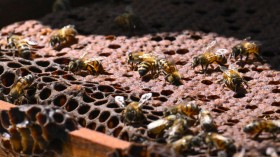Birds foraging along the banks of the Hudson River in New York are singing to a different tune, and a group of researchers suggest the inconsistency in the birdsong is a slow, but steady, internalization of polychlorinated biphenyls (PCBs).
The two-note song of the chickadee and song sparrow's long trill can be substantially altered by the low levels of PBCs in their food, the researchers write in the journal PLOS One.
PCBs belong to a family of man-made organic chemicals known as chlorinated hydrocarbons. Their chemical properties made them useful in hundreds of commercial and industrial applications. PCBs were manufactured in the US from 1929 until 1979, when their manufacture was banned due to a demonstrated ability to cause cancer and other adverse effects on the human immune system, according to the US Environmental Protection Agency.
The Hudson River has a legacy of elevated PCB levels, largely as a result of decades of electronics manufacturing upriver. Songbirds feed their young PCB-contaminated insects as their main food source, and some birds continue to eat contaminated insects throughout their lives, resulting in long-term exposure to non-lethal levels of PCBs.
Researchers from Cornell University's Laboratory of Ornithology contend that while this internalization of PCBs is non-lethal, it is still having a noticeable effect on the birds, especially in their song.
For their study, the researchers, led by Cornell's Sara DeLeon, focused on songbirds living in an area with historically high PCB contamination to birds living in an uncontaminated area of the Adirondacks. They found that black-capped chickadees and song sparrows have higher total blood PCBs in regions with higher historic PCB contamination.
DeLeon and her colleagues used a computer analysis to study the chickadee, which has a two-note "fee-bee" song and the song sparrows, which have longer, trilling songs.
The differences in the birdsongs cannot be distinguished by the human ear, but a computer sound analysis revealed variation in the birds' tune in specimens that lived in PCB contaminated area compared to those which did not.
In the PCB-contaminated areas, the chickadees' "fee-bee" song showed greater variability in the first note of the two-note song, while the song sparrows showed high performance trills that may be the result of PCB molecules present in their systems, the researchers reported.
"Effects of PCBs are extremely complicated," said co-author André Dhondt, director of Bird Population Studies at the Cornell Lab of Ornithology. "What this demonstrates is that most previous PCB studies may not give us the whole picture because they did not look at the specific type of PCB involved but just measured overall levels."
DeLeon added: "Contaminants last a long time and are pervasive. We have to take that into account when we study species in these disturbed environments and be aware of how environmental changes are affecting them."
© 2024 NatureWorldNews.com All rights reserved. Do not reproduce without permission.





